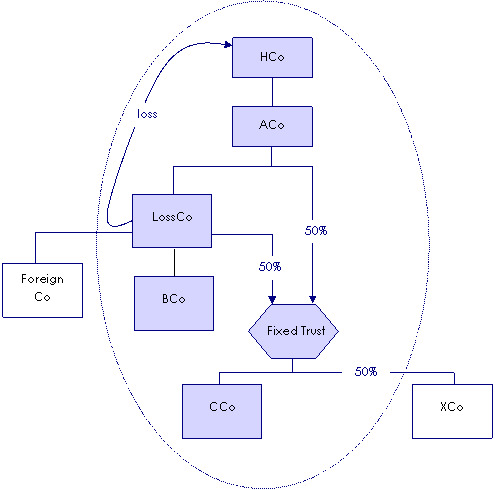Consolidation Reference Manual
You can still refer to the Consolidation reference manual for consolidation information that has not been impacted by changes in the legislation.
C3 Losses
C3-4 Worked example - loss utilisation
Calculating the available fraction
C3-4-110 Modified market value of a single joining entity
Description
When a loss is transferred from a member of a consolidated group (the real loss-maker) to the head company for the first time, an available fraction may need to be calculated ( → 'Consolidation loss provisions', C3-2-110 ) for the bundle containing the loss. In order to calculate an available fraction, the modified market value of the entity that transferred the loss must be determined as at the joining time.
This example shows how modified market value is determined for a single joining entity.
Commentary
The modified market value of an entity becoming a member of a consolidated group is its market value, assuming:
- •
- it has no losses and the balance of its franking account is nil
- •
- the subsidiary members of the group at the joining time are separate entities and not parts of the head company, and
- •
- the entity's market value does not include an amount attributable (directly or indirectly) to a membership interest in a member of the group that is a corporate tax entity or an entity that transferred losses to the head company.
An entity's modified market value may include value contributed by a fixed entitlement in another group member that is a trust. Value taken into account is so much of the trust's value that is not contributed via a membership interest in another member of the group, unless that member is itself a trust in which a fixed entitlement is held. However, an entity's modified market value cannot include the value of a membership interest in a trust that itself transferred losses to the head company or is a corporate unit trust or public trading trust.
Example
Facts
The consolidated group shown in Figure 1 formed on 1 July 2002. Subsidiary member LossCo transfers a loss at the joining time to the head company, HCo. LossCo and ACo are beneficiaries of the fixed trust - they each hold a fixed entitlement to 50% of the income and capital of the trust. If the available fraction method of utilisation is going to be used by HCo, the modified market value of LossCo must be determined as at the joining time in order for an available fraction for the bundle to be calculated.
Figure 1: HCo and subsidiary members

Calculation
The modified market value for LossCo is worked out assuming it:
- •
- has no losses
- •
- is a separate entity and not part of the head company
- •
- has no membership interest in other corporate tax entities that are members of the consolidated group (disregard interest in BCo)
- •
- can include the value of the fixed entitlement to the income and capital of Fixed Trust (that is not attributable to the trust's membership interest in CCo) that flow to it, and
- •
- can include the membership interest in Foreign Co, as it is not a subsidiary member of the group.
References
Income Tax Assessment Act 1997, section 707-325; as amended by New Business Tax System (Consolidation) Act (No. 1) 2002 (No. 68 of 2002), Schedule 1
Explanatory Memorandum to the New Business Tax System (Consolidation) Bill (No. 1) 2002, Chapter 8
Current at 2 December 2002
